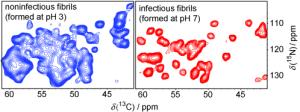|
Related Topics: |
|
Current News |
|
Chemistry A to Z |
|
About Internetchemistry |
|
- Imprint |
|
|
Tracking Prions |
|
Infectious proteins known as prions have been identified as the cause of “mad cow” disease (BSE). The culprits are “incorrectly folded” proteins that can “infect” healthy proteins. The molecular bases for such prion diseases are not yet fully understood. Why are some proteins infectious while others are not? A team headed by Beat Meier (ETH Zurich, Switzerland) and Raimon Sabaté (University of Bordeaux, France) has examined two different forms of a prion-forming protein domain by means of NMR spectroscopy. In the journal Angewandte Chemie, the researchers report that the infectious and non-infectious forms differ markedly in their molecular structure. |
|
The word prion is derived from the term Proteinaceous Infectious Particle. These are proteins that can fold in different ways. Pathogenic prions are dangerous because they can convert physiological, non-pathogenic molecules into the diseased form. Often, prions largely consist of ß-sheet structures. These are accordion-like folded protein ribbons that can easily aggregate into thread-like structures (amyloid fibrils). The research team took on the prion-forming domain of the fungal protein HET-s. At a pH value of 7 - under physiological conditions - this domain forms infectious fibrils. In acidic solution, at pH 3, it also forms fibrils, but these are not infectious. By using nuclear magnetic resonance spectroscopy (NMR), the team was able to get a closer look at this protein. NMR allows for the evaluation of interactions of the nuclear spins of specific atomic nuclei with each other and their chemical surroundings, which gives information about the structure and dynamics of molecules and molecular fragments. Here’s what the researchers found: The spectra of the pH 7 and pH 3 versions of the prion differ significantly. Both are mainly arranged in the rigid ß-sheet structure, but up close the structures diverge widely. Particularly striking is the fact that the infectious pH 7 form has highly flexible loops in addition to the rigid domains. These are absent from the non-infectious pH 3 prions. “The lack of infectiousness of the pH 3 fibrils is thus related to the fact that their molecular structure is significantly different from that of the fibrils formed at physiological pH,” the researchers conclude. |
|
|
|
|
Related topics - search form: |
|
|
